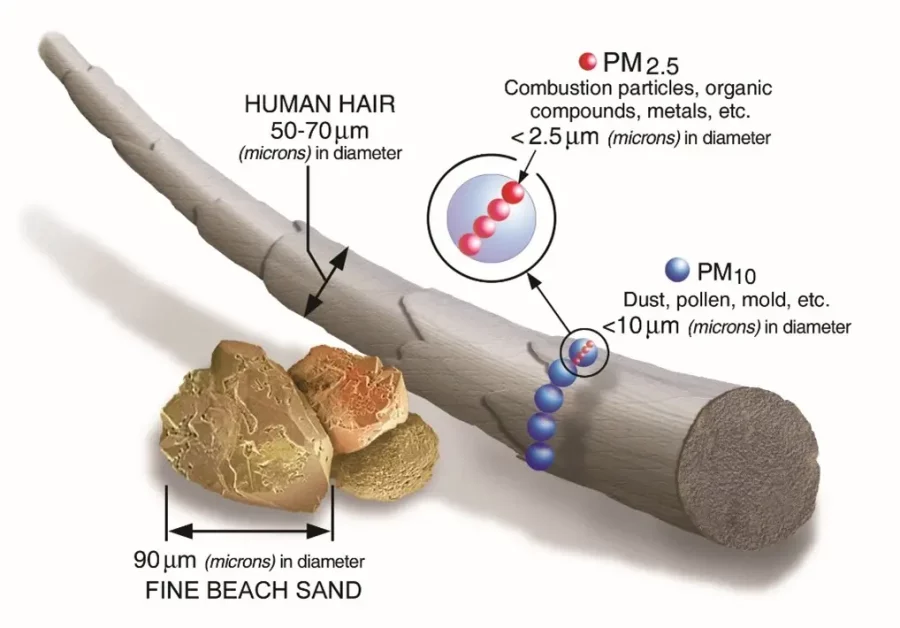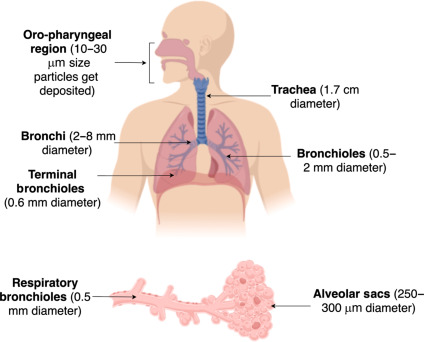
Every day, we breathe in between 10,000 and 20,000 litres of air, depending on our build and physical activity, to provide our bodies with the oxygen they need. This air contains natural pollutants such as dust and pollen, as well as primary and secondary particles. Primary particles come mainly from industrial and domestic activities, transport and agriculture. Secondary particles are formed in the atmosphere by chemical reactions involving compounds such as sulphur dioxide (SO2), nitrogen oxides (NOx) and volatile organic compounds (VOCs).
These particles are classified according to their size. The smaller they are, the more dangerous they are to human health. We talk about PM 10 and PM 2.5. Let’s take a closer look at PM 2.5 particles?
Definition of PM 2.5 particles
These are all fine particles suspended in the air with a diameter of less than 2.5 micrometres (µm). They include residues of smoke (car exhaust fumes, industrial fumes and wood combustion), soot, various dusts (construction, soil work, wind), aerosols, droplets or biological matter such as mould, bacteria or pollen.
The term PM stands for Particulate Matter. As these are solid or liquid particles, they are one dimensional, unlike gases.
What are the differences with PM 10 fine particles?
PM 10, as the name suggests, are particles with a diameter of less than 10 µm. They are generally blocked naturally in the nose. PM 10 and PM 2.5 are the particle sizes measured by the various international health services so that common standardised values can be compared.
The illustration in this article gives you an idea of what a size of 2.5µm and 10µm represents compared with a grain of sand and a hair. So we’re talking about microscopic size!
Who is responsible for the quality of the air we breathe?
When it comes to air quality, there are three levels of interlocking regulations. The first level is the responsibility of the European Member States, the second is the responsibility of each individual state, and the third is at regional level.
Despite a trend towards improved air quality over the last 20 years, limit values are still not being respected everywhere. The French government is being taken to the European Court of Justice by associations for failing to comply with maximum levels of particulate matter (PM10) and nitrogen dioxide (NO2) in around twenty conurbations.
How are PM 2.5 measured ?
A network of measuring stations around the world provides real-time information on the level of fine particle pollution. Numerous applications share this information on our smartphones.
To determine whether the atmosphere is polluted and issue warnings to the public, the authorities monitor the Air Quality Index (AQI). The AQI is calculated by taking measurements of the six main pollutants. PM 2.5 is the smallest physical suspended particle measured in this index. PM 2.5 measurements are expressed in µg/m3, with a recommended annual average of 10 μg/m3, a target value of 20µg/m3 and a limit value of 25µg/m3.
To be more precise, European directives 2008/50/EC and 2004/107/EC have been transposed into the French Environment Code (articles R221-1 to R221-3). See the decree of 21 October 2010 and the order of 16 April 2021 on the national system for monitoring atmospheric air quality.
Here are the WHO target values for the main air pollutants :

When is the alert threshold exceeded?
When the alert threshold is exceeded, it is known as a pollution peak.
It is essential to take action to reduce air pollution, because according to the World Health Organisation, almost 99% of the world’s population breathes air that exceeds the limits set by the WHO, threatening their health.
What are the effects of fine particles on human health?
According to Santé Publique France, 40,000 people die every year from air pollution. The WHO puts the worldwide figure at 7 million. PM 2.5 is a group 1 carcinogen, the most dangerous form of air pollution.
The people most vulnerable to fine PM 2.5 particles are those suffering from lung or heart disease, children whose bronchi and lungs are still developing, and the elderly.
When inhaled, fine particles represent a real danger because they penetrate deep into the respiratory tract to the lungs and pulmonary alveoli. They can even pass into the bloodstream. The main symptoms are irritation of the airways and eyes, wheezing, coughing and shortness of breath on exertion.

Even at average or even low levels of concentration, repeated long-term exposure to air pollution can have very harmful effects on health. Many studies demonstrate the role of pollution in reducing life expectancy and mortality. The effect is also visible in the development of cardiovascular disease, lung disease, asthma and lung cancer.
According to Santé Publique France, a 10 µg/m3 increase in PM 2.5 increases the risk of total non-accidental mortality by 15%.
Air pollution is also thought to have an impact on mental health. Experts from Santé publique France explain the impact of pollution on the brain: “Fine particles can destroy the blood-brain barrier or penetrate the olfactory nerve in the brain”, as well as the part of the digestive tract that includes the stomach, small intestine and large intestine, causing imbalances that affect the central nervous system.
What are the effects of PM 2.5 particles on nature and the environment?
The effects of fine particles are difficult to study because of their short lifespan. They only remain in the atmosphere for about a week.
Nitrogen oxides (NOx) and sulphur dioxide (SO2) make rain, snow and fog more acidic. This alters the quality of soil and water through the loss of mineral nutrients, leading to a complete imbalance in ecosystems.
Pollution particles blacken buildings and attack stone, making it brittle.
How can I protect myself from fine particles?
There are a number of simple steps you can take to limit the proliferation of fine particles, both in terms of ventilation and prevention.
- Air your home for at least 30 minutes a day, except on days with high levels of outdoor pollution
- Eliminate smoking in the home
- Ensure that combustion appliances are properly installed and maintained
- Use a hoover fitted with a High Efficiency Particulate Air (HEPA) filter
- Reduce the use of candles and incense
- Reduce the use of solvents and household products by choosing the most natural formulas
- Use the cooker hood at full power when cooking
- Install a quality air purifier in living areas
Is an anti-pollution mask effective against PM 2.5 ?
If you’re a cyclist or motorcyclist in an urban area, wearing a mask becomes all the more necessary because you’re riding in the middle of traffic where pollution is most concentrated.
An anti-pollution mask is useful for reducing the quantity of particles inhaled. Depending on its filtration standard (FFP1, FFP2 or FFP3), it will filter out 90% to 99% of particles down to 0.4µm. It’s not a miracle item unless you opt for a professional gas mask, but it’s not the same story.
When choosing a good anti-pollution mask, you also need to be careful to choose the right size for your face. If the mask is too large, the air breathed in will pass through the sides and not through the filters. It’s best to avoid one-size-fits-all masks, as we all have different face shapes.
Frogmask anti-pollution masks combine all the advantages of a good mask for cyclists or motorcyclists :
- Lightweight 3D Mesh fabric for long-lasting comfort
- A repositionable fastening system at the back of the neck that does not interfere with wearing a helmet and ensures optimum airtightness around the face.
- Removable FFP2 filters with a lifespan of 2 to 3 weeks, depending on the intensity of use and the level of pollution.
- Filtration of at least 94% of particles down to 0.4µm
- Available in 3 sizes: M, L and XL
- Price under €40 incl. VAT, with free delivery and a one-year guarantee
- 5 colours and a rather pleasant look compared to “paper” FFP2 masks

PM 2.5 particles hold no secrets for you. Even in our towns and cities, which are much less polluted than those in South-East Asia, the quality of the air we breathe remains a real issue. It is strongly recommended that we take all the necessary measures to protect ourselves, because exposure to particles, even at low concentrations, can have serious long-term consequences.
